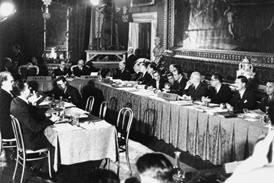England has a rich history of legal innovation. The freezing injunction (previously known as a Mareva injunction), which celebrated its 50th anniversary last month, is a prime example of our legal system innovating to protect those who obtain a judgment or arbitration award (in an English-seated arbitration) and then find that the assets against which they intended to recover have vanished – the so-called pyrrhic victory.


It is generally accepted that the domestic freezing injunction was created by the Court of Appeal in 1975 (judgment was published in 1980), when it upheld the interim order granting the initial injunction over sums held in a bank account in Mareva Compania Naviera SA v International Bulkcarriers SA. HFW acted for the successful applicant in the case. The name of the case became synonymous with the relief provided by the injunction.
A freezing injunction is an order preventing a party from using or disposing of their assets – effectively ‘freezing’ them at the time the order is made so that they are available to satisfy a judgment or arbitration award. It extends to assets held directly by the respondent, and also those held by third parties, whether located within England or internationally: the worldwide freezing order (WFO).
A respondent can be ordered to disclose the existence and location of their assets, as part of the application to secure a freezing injunction. This is particularly helpful if the applicant has been unable to trace the assets.
It is an important part of the litigation armoury and there are serious consequences for misuse or breach. Freezing injunctions are usually obtained without notice to the respondent. As such, the court requires full and frank disclosure of all material facts whether supporting or adverse to the application. A penal notice is attached to the order granting the injunction, and any breach could lead to contempt of court and criminal proceedings. In order to protect respondents from loss caused by a freezing order obtained unfairly, the applicant will be required to make a cross-undertaking in damages to the court, which can be required to be supported by a payment to court or bank guarantee (that is, fortified).
Development of the freezing injunction
As mentioned, the creation of the freezing injunction represented a significant development in English law. Lord Denning (pictured), presiding over the Mareva case, described it as ‘the greatest piece of judicial law reform in [his] time’.
Initially available to prevent financial assets within the jurisdiction from being moved abroad where there was a cause of action before the English courts, the injunction has developed:
- to apply to non-financial assets and other forms of ‘property’;
- to become an option before proceedings are issued, and also where there is no cause of action linked to the application;
- to apply to assets located in other jurisdictions – creating the WFO; and
- to apply to third parties (Chabra injunction).
The requirements needed to obtain a freezing injunction have similarly evolved. Initially, the applicant needed to prove that the respondent had ‘nefarious intent’. However, the bar has been lowered by more recent cases holding that there need only be a ‘real risk’ of the respondent disposing of the assets.
In an example of the English courts keeping pace with modern claims, it is now possible to issue a freezing injunction against ‘persons unknown’, particularly useful in crypto fraud cases.
The model order used to obtain a freezing injunction was revised this year to take into account many of the changes including those to asset class. This supports a clearly understood and consistent approach to the injunctions being made, and the efficiency of the process.
International impact
The English courts will consider issuing a freezing order in support of foreign proceedings where:
1. they are already under way/about to be commenced;
2. granting the freezing order would be consistent with the laws of a foreign jurisdiction;
3. the freezing order would be granted in similar English proceedings; and
4. it is expedient to do so.
Several common law jurisdictions have adopted the English approach and offer some form of ‘freezing injunction’ to secure assets and enable them to be used to satisfy a judgment or arbitration award. For example, the freezing-injunction model has been adopted by jurisdictions such as Australia, Canada, Dubai, Ireland, Hong Kong and Singapore. Other jurisdictions offer similar orders, for example pre-judgment attachments in New York or anti-dissipation orders in South Africa. The relevant legal tests and scope vary between jurisdictions, but all are examples of how the English model has been adopted internationally.
Conclusion
Over the past 50 years, the freezing injunction has evolved from a narrow domestic injunction to one with global influence. From its origins in the Mareva case, the remedy has expanded in flexibility, scope and international reach.
London remains the global leader in innovative freezing injunctions that meet the challenges created by modern litigation. It is an attractive option for parties to foreign proceedings where local relief is not available, where it would be quicker to obtain a WFO in England to be enforced locally, or where the local equivalent would be limited in scope.
Damian Honey is a partner and Nicola Gare disputes knowledge counsel at HFW, London































2 Readers' comments